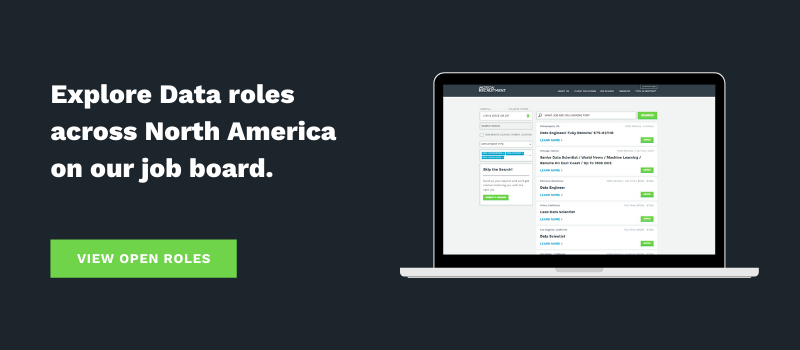What's in a Job Title? Solving the Data & AI Engineering Identity Crisis
The big data industry alone is seeing the biggest influx of job postings ever, with 37,000 data engineering jobs on the market monthly on average. However, how many of those job postings correctly describe what a data engineer does? With more and more companies introducing data science and engineering roles for the first time, job titles and descriptions are getting muddled and candidates might be applying for positions that are different from their skillsets.
Read: The Highest Paying Salaries for Data Jobs in 2022
Those in the data science field are working with companies to develop new products and find the right mediums where customers can find them, identify potential fraud, and most importantly better understand their customers. With the technology to meet those goals becoming increasingly more advanced, the reason businesses are searching for those working in data and AI is clear. However, not all companies looking for data-centric roles for the first time (or umpteenth) are experts in the field. They’ve heard the hype and see the benefits, but aren’t always sure how to go about properly hiring personnel.
What happens next? Job boards are flooded by open roles with job titles that don’t necessarily match a description.
"Most companies are confused on how to title their data jobs," said Motion Recruitment Data Practice Manager Seif Tadros. "I've worked with companies that have said they are looking for a Data Scientist, but after reading the job description, what they are really looking for is a Machine Learning Engineer."
To complicate things even further, even companies that have a better understanding of what these roles entail have different definitions of what each job does. One company’s Data Analyst is another’s Business Analyst is another’s Data Specialist. This confusion leads to the wrong candidates applying for the wrong jobs, with both sides missing out on possible successful partnerships.
Keep reading for how to navigate the current data job title identity crisis.
How to avoid the pitfalls that many are dealing with when it comes to data roles? Here are a few ways, according to the experts.
Do: Learn the Industry Standards for Titles and Job Descriptions
Below are some general guidelines of the job descriptions for the most popular job titles companies are looking for. However, make sure to look at job postings from businesses that are similar to yours to see what titles and responsibilities they are using. Find out your industry’s standards and fit those into the requirements.
Data Analyst: Turning raw data into insights to guide business decisions, data analysts are one of the most common job titles in data. Using already existing automated tools, they work with programmers engineers, and others to find opportunities for improvement across a company.
Data Scientist: More advanced than an analyst, a data scientist should have the ability to build models that can provide answers to complex multi-faceted questions.
Business Analyst: With a lower threshold needed for knowledge of the technical side of analytics, business analysts nevertheless use data to make companies more efficient and reduce costs. Critical thinking and an understanding of a business’s objectives are vital to the success of these positions.
Read More: Why More Tech Workers and Companies are Choosing Contracting
%20(2).png?width=1140&name=Copy%20of%20Mental%20Health%20Posts%20(1140%20%C3%97%20300%20px)%20(2).png)
Do: When Hiring, Look at a Candidates's Full Range of Skills
If you’re a hiring manager, when vetting candidates, read a candidate’s skillsets and job duty descriptions. Someone working in a small department might have been essentially working multiple roles at once, so a job title might not tell the whole story of their experience. Additionally, with the previously discussed job title confusion across the data field, a candidate might have the exact qualifications you need, but they are hidden in a description of a role, rather than right out front in a job title.
%20(3).png?width=1140&name=Copy%20of%20Mental%20Health%20Posts%20(1140%20%C3%97%20300%20px)%20(3).png)
Don't: Only Look at a Job Title When Applying
On the other side of the equation, when searching for any job in the data or AI field, one of the least important things to look at is the job title. Search skills and keywords instead of job titles, and read the full descriptions to find out if your skillset is the right fit for the position. Once in the interview process, describe how your role fits in with what they are looking for.
The need for data science roles will continue to grow - increasing 28% by 2026 according to the U.S. Bureau of Labor Statistics. As more companies invest in these positions, having a better understanding of what job - rather than title - you’re looking for will save you time and frustration while searching for your next role or team member.
Working in the mid-to-senior level IT talent industry for over 30 years, Motion has set itself apart in the technology space by having recruiters specialized in specific segments of the tech industry, allowing them to become experts in a particular section of the IT workforce. With offices in 16 cities across the United States and Canada, Motion can help companies and candidates take the next step in the tech market. Want to know more about the market you're in? Download our Guide below.


